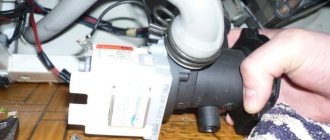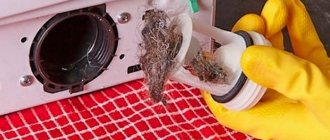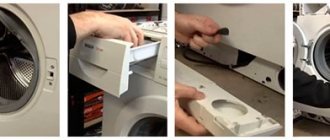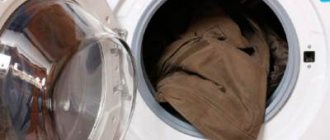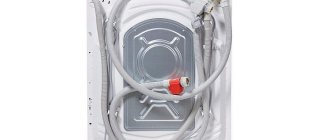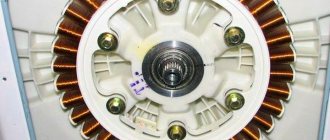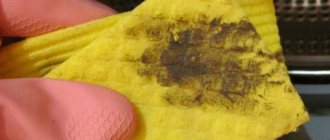Modern household appliances are reliable and highly functional. In order for it to serve for a long time and effectively, it requires appropriate care.
For a Bosch washing machine, these requirements include the need to regularly clean the drain filter.
We'll tell you how to clean the filter in a Bosch washing machine in this article.
When should cleaning be done?
Manufacturers of Bosch machines have tried to minimize the risk of clogging of internal components, as well as to develop a special indication system with which you can easily receive a signal about the need for cleaning.
Main indicators of clogging:
- water drainage is difficult;
- unstable work;
- reduction in spin quality;
- an error message appears on the display.
When washing items made from down, it is best to immediately clean the filter, since this material tends to accumulate and complicate the operation of the entire machine.
All of the above points indicate that it is necessary to carry out a special cleaning procedure, after which the functionality of the device should be fully restored.
The service life of the machine until the next cleaning is influenced by many factors .
The intensity of use, frequency of washing, materials processed and much more are important here. When washing once a week, there is no need to clean the filter more than once every three months. Active use may require monthly cleaning.
Operating rules
Regular filter cleaning will extend the life of the machine and improve the quality of its operation. However, it is equally important to ensure cleanliness when washing.
To do this, it is recommended to pay attention to the following:
- Before you start washing, you need to check the contents of the pockets and make sure that there are no foreign objects there.
- If you need to wash clothes with beads or other parts that can come off, it is recommended to put them in a cloth bag.
- You need to check that there are no clothes with poorly sewn buttons.
By reducing the risk of contamination, the owner takes care of the health of his washing machine and helps to increase its service life.
Location of the element in the Bosch washing machine
On traditional horizontal-loading machines, the cleaning elements are in most cases located on the front panel. Older models do not provide any plugs, so the component protrudes slightly. For new devices, such a cover has already become commonplace.
Lid opening options:
On the bottom of the front panel there is a special strip that occupies the entire edge. This cover is secured with latches, the opening of which will allow the user to gain direct access to the washing machine filter.- On the right there is a small rectangular lid that can be opened with a knife or screwdriver.
- The round hatch closes the element or opens it with a light touch.
Horizontal loading washing machines are also equipped with filters. Most often, it is located in the front part of the case behind a small rectangular or round cover. At the same time, the removal of the component and subsequent cleaning is not much different from a similar process on machines with horizontal loading.
Models of washing machines produced before 2005 did not have drain filters. So it will be useless to look for any cover.
On such devices, the volute could sometimes become clogged , which cannot be cleaned without separating the pan and disconnecting the pipes.
How to get rid of dirt in the washing machine?
What to do: Mix baking soda and water in a small bowl, add the soda mixture to your machine's detergent tray, and pour the vinegar into the drum. Idle the car at the highest temperature for the longest time possible. Cleaning a washing machine with citric acid is even easier.
Interesting materials:
How to change font on Xiaomi Redmi 8? How to change the purpose of non-residential premises? How to change the founder and CEO at the same time? How to change UEFI on Legacy ASUS? How to change UEFI on Legacy Gigabyte? How to remember relatives? How to wash a sofa? How to wash horizontal blinds from grease? How to wash a tiled floor without streaks? How to wash a lg refrigerator?
Preparatory activities
Once the user has been able to detect the filter on the body of the washing machine, it is recommended to take a number of additional measures aimed at ensuring the safety and convenience of the cleaning procedure.
First of all, you must immediately turn off the power supply and shut off the water supply . After this, you need to tilt the car back a little and place a basin under the lower part of the body, and also stock up on rags to remove water.
Even if the machine is idle for a long time, a certain amount of water still remains inside the machine, which can easily flow out through the hole.
Cleaning steps
Before removing the drain filter, it is necessary to prepare a flat container and floor rags, since water may accumulate at the location of the filter. Next you need to perform the following manipulations:
- turn off the power to the household appliance;
- spread the rags on the floor and prepare a container for draining the water;
- open the panel and unscrew the required part;
- clean the filter from dirt and foreign objects;
- Carefully clean the hole in the machine where the filter will be installed later;
- install the filter in its place;
- close the panel.
Step-by-step instruction
Once all preliminary operations have been completed, you can proceed directly to cleaning.
Tools
To carry out all the activities to clean the filter and return the machine to the necessary functionality, you will need a certain set of additional tools:
- a basin and rags to collect leaking water;
- knife, screwdriver or anything suitable for prying off the lid;
- cloths for wiping.
Preparing for cleaning
After ensuring safety and turning off the power, you should finally start preparing the filter. This process involves opening the cap on the washing machine body, draining the water from the hose, and removing the component itself.
To remove the element, you need to unscrew the retaining plug counterclockwise. It is worth remembering that there is water not only in the hose, but also in the seat.
So when removed from the hole, water will flow, which must be quickly collected using rags and a basin.
Process
The cleaning process includes a visual inspection of the filter and drain hole for the presence of various types of contaminants.
Any extraneous items are also removed. Cleaning is completed by wiping the elements with a specially prepared cloth .
Now you need to insert the element back and screw it clockwise until it stops. Then the plug is closed, and all additional containers and rags are removed.
If the housing was raised before cleaning, it must be returned to the desired position.
What to do if it is impossible to unscrew the filter?
Most often, this element is removed without much difficulty. However, there have been cases in which the filter was not removed, as if it was firmly stuck, and you will have to use special tools to remove it.
Don't rush to pick at the part to remove it.
If the thread does not lend itself, we try to partially disassemble the Bosch SMA by removing the front panel. In this case, access to the drain point is opened - a pair of pipes, a drain hose, a pump and a volute, where the element we need for cleaning is located. Loosen the fastening clamps of the pipes and remove the volute complete with pump and filter.
Now we proceed in the following sequence:
- we place the snail removed from the Bosch washing machine with the fitting facing the ceiling;
- move the pump all the way in a clockwise direction;
- the stopper in the form of a mustache must be squeezed out;
- turn the pump again in the direction of the arrow to pull it out;
- access to the insides of the cochlea has opened, which must be cleaned and the block assembled in the reverse order.
We were able to perform cleaning without removing the element itself. To avoid disassembling the washing machine in the future, it is recommended to soak the snail in a special lubricant WD-40 so that the threaded connections acidify.
Possible problems and solutions
Cleaning the filter involves partial disassembly of a rather complex unit. It is quite natural that in some cases, after carrying out the described procedures, various kinds of problems may arise. In most cases, they are associated with water seepage or leakage.
Main causes of problems:
Uneven or insufficiently tight placement of the part in the drain compartment.
When placing the element, it is important to avoid shifts and also monitor the tightening force. But you shouldn’t use too much force, as the plastic threads can easily break off, which will lead to constant leaks.- Gasket failure. It is the gasket that creates the necessary conditions for isolating the system from the external environment. But under the influence of time, this component can wear out and lose its properties. As a result, leaks occur. You can get rid of this kind of defect by replacing the gasket.
- Filter failure. Excessive cleaning and screwing force may result in component failure. In this case, the contact between the walls becomes less dense, which creates the necessary conditions for the passage of water. This problem can be solved by replacing the cleaning unit.
Other reasons for slow drainage
A clog at the filter level is a common, but not the only reason for slow or non-existent drainage. Quite often it is caused by a malfunction of the pump (pump), problems with the pressure switch (water level sensor) or malfunctions of the control module. Sometimes it happens that water is drained on some programs, but not on others. In this case, the mechanical components of the device are working properly; the problem should be looked for in the electronics.
Drain pump failure
The pump is responsible for pumping dirty water from the tank through a system of pipes and hoses directly into the sewer. The pump is usually installed at the bottom of the machine, under the tank. This arrangement allows the device to optimally perform its function. Over time, the pump, like the drain filter, may become clogged, and then the water will drain very slowly. When metal objects (keys, coins, buttons) enter the drain system, they often break the impeller blades or damage the pump body. A complete lack of drainage most often indicates a violation of the integrity of the pump or combustion of the motor as a result of voltage surges.
Electronics malfunction
This breakdown is somewhat less common than the ones listed above. However, it is this that is the most difficult and expensive to eliminate. All processes in the machine are controlled by an electronic module; it is this module that activates the pump. At the right moment, a command is given to turn on the pump, and when all the liquid is pumped out of the tank, a signal to turn off is given. If the wiring or triac of the pump burns out, the connection between the nodes is interrupted, and water will not be drained, even if the pump is working.
Such repairs are not cheap, because the repairs are carried out by highly specialized electronics specialists. But they, as a rule, give a guarantee on their work for a month or two. After this period, the problem may return. In addition, it is not always possible to restore a damaged control unit, and replacing it is impractical due to the high cost of the spare part itself. Therefore, if you have such problems with electronics, you should seriously think about buying a new washing machine.
Problems with the water level sensor
A faulty pressure switch can also cause a lack of drainage and malfunctions in the washing machine. Thanks to this sensor, the electronics “see” whether there is now enough water in the tank to complete the wash. If the pressure switch measures the level incorrectly or does not receive signals from it at all, the program will freeze. It is better to replace a broken sensor, since washing its tube or cleaning the contacts usually helps for a short time, and the user again faces inconvenience.
How to remove and clean the fill filter
Almost all modern units are equipped with a mesh fill filter. To gain access to it, you need to disconnect the inlet hose from the washing machine, first turning off the water supply tap.
Before unscrewing the hose, it is necessary to place a small cloth under the fitting so that residual water does not fall on the back wall of the machine or the floor. Using pliers, grab the filter by the protruding part and pull it towards you. After removal, you need to inspect the mesh for dirt, and if necessary, clean it under running water using an old toothbrush.
A clogged inlet filter can be judged by a small pressure or no water flow at all; when you start washing, powder is poured into the tray. In addition, there are washing units equipped with indicators warning of filter clogging.
